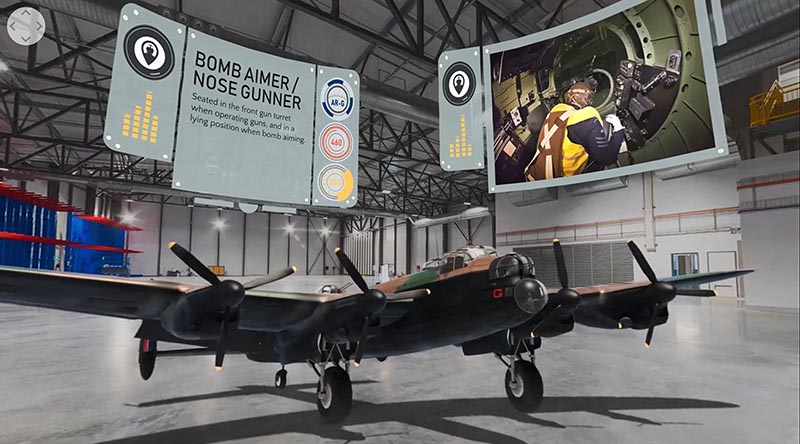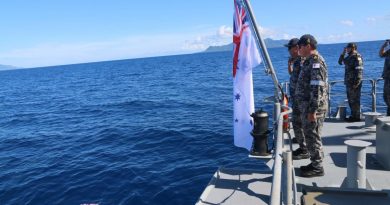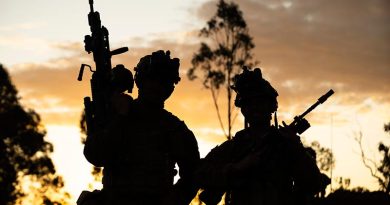Explore “G for George” in 3D

The Australian War Memorial has launched the fifth and final instalment of On Closer Inspection, a series of immersive digital experiences that share the stories behind iconic large military objects through virtual 360-degree video and 3D digital modelling.
VIEW the 3D interactive G for George experience here.
The final edition of On Closer Inspection allows online visitors to explore an Avro Lancaster B1 from the Second World War, and to understand the history of Lancaster bombers such as the famous “G for George” in the Memorial’s collection.
Australian War Memorial Director Matt Anderson said the experience was as close as most people would ever get to being inside a Lancaster bomber.
“Most people will never get the chance to sit in the cockpit of a Lancaster bomber like “G for George”,” Mr Anderson said.
“This experience will allow people to examine this remarkable aircraft from any angle, both inside and out.
“All they need is an internet connection, a device and an inquiring mind.
“Australian service in Bomber Command during the Second World War is one of the many powerful stories told here at the Australian War Memorial.
“Of the 10,000 Australians who served in Bomber Command, 4100 were killed, making it the most dangerous of duties for Australians during the war.
“Through this digital experience, those who are unable to travel to Canberra will still be able to marvel at the Lancaster bomber and imagine what it must have been like to have flown or supported G for George.
“And for those who are able to visit, we hope this digital experience will lead to a deeper understanding of and appreciation for all who served in Bomber Command.
“And the timing of the experience is perfect, coming on the eve of the centenary of the Royal Australian Air Force in 2021,” he said.
The Lancaster bomber is the final 360-degree immersive experience to be launched in partnership with Leidos Australia.
It complements the previously launched experiences of an Adelaide-class frigate, a Mark IV tank, a Hudson Bomber and a Bushmaster Protected Mobility Vehicle (PMV).
Vice President of Corporate Affairs and Industry Engagement for Leidos Australia Simon Carr said Leidos was proud to work with the Memorial on the innovative On Closer Inspection project.
“Leidos is focused on the development of science and technology solutions,” Mr Carr said.
“That’s why we are so pleased to have played a pivotal role helping the Memorial to use new technologies and interpret the experience of war and its enduring impact on society.”
On Closer Inspection is available in three versions to ensure that the experience is accessible to as wide an audience as possible.
It is available on the Memorial website using React 360 VR technology; on YouTube 360; and now as a VR headset experience downloadable from the Steam store.
Background on Lancaster bomber “G for George”
George’s story reflects the experiences of thousands of Australians who served in Bomber Command in Britain, fighting in the Allied bombing campaign over Germany and occupied Europe.
George commenced service with No. 460 Squadron RAAF, flying its first operation in December 1942.
“G for George” is credited with 90 missions between 1942 and 1944, which are marked on its port side – however squadron records indicate that George completed 89 operations, plus four that were aborted after take-off.
Lancasters had a crew of seven.
During its service George was crewed by some 220 men on operations, 80 of whom were killed when flying missions in other aircraft.
George was damaged by flak and gunfire on multiple operations but, as it became the oldest-serving aircraft in No. 460 Squadron, it gained a reputation as a very special aircraft, and was seen as something of a lucky charm – if you flew in George, you would return safely.
As a tribute to the aircraft itself, the colours and ribbons of the Distinguished Flying Medal and Conspicuous Gallantry Medal were painted on its side.
This act was described in a RAAF report as “an affectionate tribute paid to George by the men who remember the bomber as the luckiest and the most reliable that they have ever flown, and the best ever serviced”.
More than 7000 Lancaster bombers were manufactured during the war, more than half of which were lost in action or accidents.
Lancasters were an iconic aircraft of the Second World War – a symbol of the Allies’ will to win by taking the war to the heart of Germany.
In October 1944 an experienced and decorated crew flew George from Britain, via the United States, to Australia, where it became the star attraction of the Third Victory Loan tour, flying to towns and cities across south-east Australia.
The aircraft was retired in July 1945, after making its final flight to Canberra.
George was first displayed at the Australian War Memorial in 1955, and has since become cherished by visitors over several generations.
.
.
.
.
.

.
.





